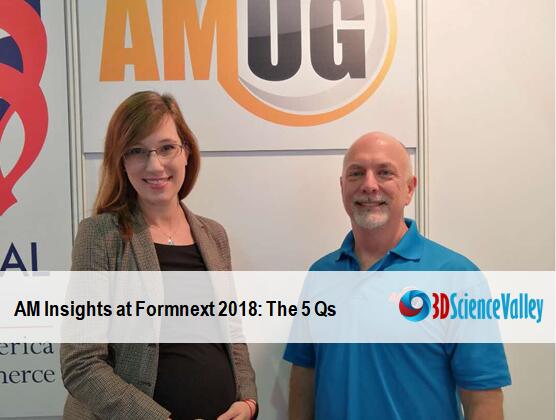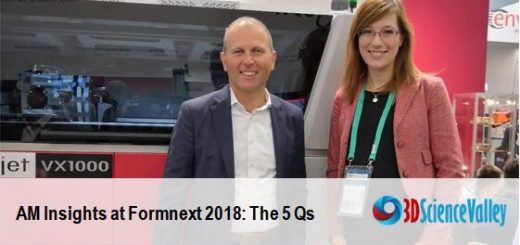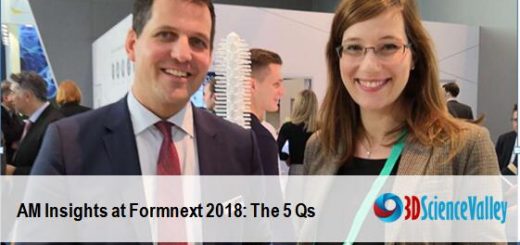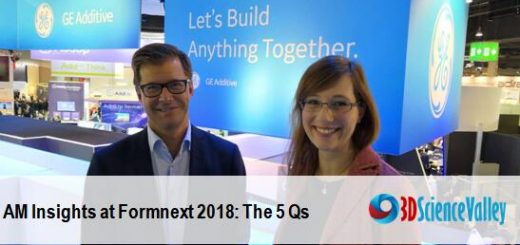AM Insights at formnext: 3D Science Valley interviewed with Paul Bates, Additive Manufacturing Lead Development Engineer, UL; President of AMUG

Left: Paul Bates, Additive Manufacturing Lead Development Engineer, UL; President of AMUG
Right: Korinna Penndorf, Co-founder of 3D Science Valley
Q1: What’s your highlights here at Formnext?
So as for AMUG, it is nice here to meet all of our sponsors. Also there are a lot of exhibitors here who will attend AMUG in Chicago April 2019. It is nice to meet with them.
All the AMUG officers are voluteers, I work for UL. For UL, I can do a little bit research here. Recently UL has annouced the new program of additive manufacturing safety, and we are happy to introduce to the manufacturers. Maybe they have several different machines and talk to about supporting them from a safety perspective.
There’s so many new companies with data management, data security, and simulation software. That’s something that UL is quite interested in.
Q2: If you compare this year business performance as opposed the last year, how has it been?
We’re seeing growth, because our customers are printing more parts now than ever before. So from a UL perspective, as our customers are making more parts and do more production versus prototyping. What we’re seeing just general growth. Obviously, metals is growing very rapidly, new players coming in pretty quickly. And just the overall number of machines that have been installed, is growing very, very fast. So new people that are learning special techniques and special methods, UL is here to support each other in getting their jobs done.
Also for AMUG, there are people have been in 3d printing for thirty years and the new comers have that opportunity to sit next to them, and learn from the experts, interact with them directly.
Q3: What are the major challenges that you are currently facing?
I think the growth is one of the biggest challenges. I mean growth is a great thing. It’s really awesome that we’re seeing growth. But when we see that more companies are implementing additive for production, that’s a wonderful thing, but the risks are actually greater because of that.
Whether the risk is coming from the production itself, or from the investment, if we can not manage the risk very well, this could hurt the industry, the faster we see growth, the more risk we need to manage.
To manage the risk, education is the key. Through education, the users can be smarter. For the company which is buying into the technology, knowing what you’re buying, having a really good business plan.
If it is not the best business plan, probably gonna fail. And that hurts you and hurts your business, hurts your investors, at the same time, hurts the industry.
So I think becoming more educated, not just to see the value that we’re seeing from additive manufacturing, but to see challenges that coming up together, that can help us to be more effective and more innovative in the end.
Q4: How would you look at the year 2018 for the overall industry: what’s been the major developments and obstacles for the industry?
Well, for 2018, I think there are a lot of development, whether it’s polymer coated metals, whether it’s Desktop Metal or HP or others. I think that is very interesting space to be in right now. It is not at all tell all solution like it’s going to work for everything, but it is impacting the way we are working for manuafucturing. For example, it is really interesting for a person who can leverage expertise in metal injection molding to other areas by using this new technology.
So I think the concerns raise up about whether we can use this addtive manufacturing technology work on these parts which we have be get used to and whether we can use them in effective way to add value to the customers.
Q5: How do you think things will develop over the next 5 year?
Well, you know, I guess that looking ahead five years is always a little challenging, because we may have an answer, but it doesn’t mean that is what will happen. So predicting the future is always a bit of challenge. I think that I’ve said it years passed and it’s been sort of true, the material development has to be a major factor. And in the growth, we’re going to see because good application has to be driven by materials.
We’re seeing a lot more talk of copper now in the metal side, and it’s a huge opportunity. Other materials, whether it’s reinforced plastics or new ceramic, I think that is going to be additional materials coming in 5 years, those are different materials, which is going to drive different applications or more applications.




Recent Comments